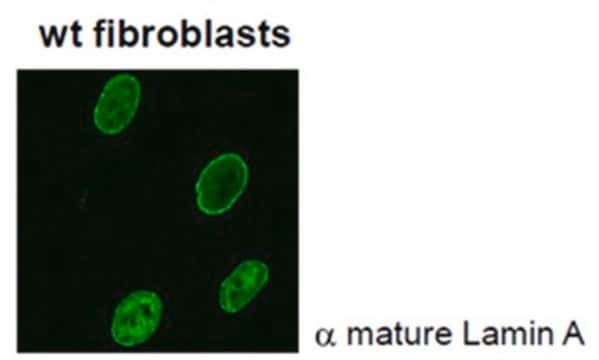General description
We are committed to bringing you greener alternative products, which adhere to one or more of The 12 Principles of Green Chemistry. This antibody is Preservative-free, produced without the harm or sacrifice of animals and exceptionally stable to allow for ambient shipping and storage if needed and thus aligns with "Waste Prevention", "Designing Safer Chemicals" and "Design for Energy Efficiency".
Click here for more information.
ZooMAb® antibodies represent an entirely new generation of recombinant monoclonal antibodies. Each ZooMAb® antibody is manufactured using our proprietary recombinant expression system, purified to homogeneity, and precisely dispensed to produce robust and highly reproducible lot-to-lot consistency. Only top-performing clones are released for use by researchers. Each antibody is validated for high specificity and affinity across multiple applications, including its most commonly used application. ZooMAb® antibodies are reliably available and ready to ship when you need them.
Specificity
Clone 1J8 is a ZooMAb® rabbit recombinant monoclonal antibody that specifically detects Insulin degrading enzyme (IDE). It targets an epitope within 20 amino acids from the N-terminal region.
Immunogen
KLH-conjugating linear peptide corresponding to 20 amino acids from the N-terminal region of human Insulin degrading enzyme (IDE).
Application
Quality Control Testing
Evaluated by Western Blotting in C2C12 cell lysate.
Western Blotting Analysis (WB): A 1:1,000 dilution of this antibody detected IDE in C2C12 cell lysate.
Tested Applications
Western Blotting Analysis: A 1:1,000 dilution from a representative lot detected IDE in lysates from A431 cells and Rat Brain tissue and 1:10,000 dilution in lysate from K562 cells.
Immunocytochemistry Analysis: A 1:100 dilution from a representative lot detected IDE in C2C12 cells.
Affinity Binding Assay: A representative lot of this antibody bound IDE peptide a with a KD of 7.4 x 10-7 in an affinity binding assay.
Immunohistochemistry (Paraffin) Analysis: A 1:100 dilution from a representative lot detected IDE in human stomach tissue sections.
Note: Actual optimal working dilutions must be determined by end user as specimens, and experimental conditions may vary with the end user.
Target description
Insulin-degrading enzyme (UniProt: P14735; also known as EC:3.4.24.56, Abeta-degrading protease. Insulin protease, Insulinase, Insulysin) is encoded by the IDE gene (Gene ID: 3416) in human. IDE is ubiquitously distributed in insulin-sensitive and insulin-insensitive tissues and in detected in multiple cellular compartments. It is a conserved, homodimeric, zinc endopeptidase that is involved in the degradation of a number of biologically active peptides. It plays a role in the cellular breakdown of insulin, APP peptides, natriuretic peptides, glucagon, and other peptides, and thereby plays a role in intercellular peptide signaling. Substrate binding to IDE induces important conformation changes, making it possible to bind and degrade larger substrates. In its monomeric form, IDE has two roughly equal sized domains: IDE-N and IDE-C that are connected by a 28 amino-acid residue loop. These two halves come together to form a crypt that encloses its substrates and prevents entry or escape. The crypt is reported to have a volume of about 15,700 nm, which excludes peptides larger than ~ 70 amino acids. Its catalytic site is located inside the crypt in IDE-N. This site is rich in charged, polar, and hydrophobic patches that facilitate interaction with both IDE-C and substrates. IDE-N also possesses an exosite, which is about 30 nm away from the catalytic site. At this site, the N-termini of ligands are tethered. This site may play a role in the positioning of insulin for cleavage. IDE plays a role in the degradation and clearance of APP-derived amyloidogenic peptides that are secreted by neurons and microglia. Its presence in the brain and cerebrospinal fluid represents a pathophysiological link between type II diabetes and the late onset of Alzheimer′s disease. Two isoforms of IDE have been described that are produced by alternative splicing. This ZooMAb® recombinant monoclonal antibody, generated by our propriety technology, offers significantly enhanced specificity, affinity, reproducibility, and stability over conventional monoclonals. (Ref.: Pivovarova, O., et al. (2016). Ann. Med. 48(8); 614-624; Zhao, J., et al. (2009). Mol. Neurodegener, 4; Article 4; Hulse, RE., et al. (2009). Vitam. Horm. 80; 635-648).
Physical form
Purified recombinant rabbit monoclonal antibody IgG, lyophilized in PBS, 5% Trehalose, normal appearance a coarse or translucent resin. The PBS/trehalose components in the ZooMAb formulation can have the appearance of a semi-solid (bead like gel) after lyophilization. This is a normal phenomenon. Please follow the recommended reconstitution procedure in the data sheet to dissolve the semi-solid, bead-like, gel-appearing material. The resulting antibody solution is completely stable and functional as proven by full functional testing. Contains no biocide or preservatives, such as azide, or any animal by-products. Larger pack sizes provided as multiples of 25 µL.
Reconstitution
300 µg/mL after reconstitution at 25 µL per vial. Please refer to guidance on suggested starting dilutions and/or titers per application and sample type.
Storage and Stability
Recommend storage of lyophilized product at 2-8°C; Before reconstitution, micro-centrifuge vials briefly to spin down material to bottom of the vial; Reconstitute each vial by adding 25 µL of filtered lab grade water or PBS; Reconstituted antibodies can be stored at 2-8°C, or -20°C for long term storage. Avoid repeated freeze-thaws.
Other Notes
Concentration: Please refer to the Certificate of Analysis for the lot-specific concentration.
Legal Information
ZooMAb is a registered trademark of Merck KGaA, Darmstadt, Germany
Disclaimer
Unless otherwise stated in our catalog or other company documentation accompanying the product(s), our products are intended for research use only and are not to be used for any other purpose, which includes but is not limited to, unauthorized commercial uses, in vitro diagnostic uses, ex vivo or in vivo therapeutic uses or any type of consumption or application to humans or animals.





